By Aimee Ortiz
On a miserable, drizzly day in late June, Hayley Hardstaff, a marine biologist, took a walk along Portwrinkle Beach in Cornwall, England, and discovered a dragon. It was a Lego piece – black, plastic and missing its upper jaw.
Hardstaff, who grew up in Cornwall, had a long history of finding Lego pieces. As a child there, she collected them from the beach, puzzled about why so many children were forgetting their toys.

Life rafts, collected by Tracey Williams in Cornwall, England, were among the Lego pieces on the ship.Credit: The New York Times
By the time she went walking last June, she knew much more, and quickly recovered the scaly head and neck poking out of the sand, “its entire dragonhood on display”.
Hardstaff had found yet another tiny artefact of one of history’s oddest maritime mishaps.
In 1997, nearly 5 million Lego pieces – including 33,427 black dragons – were packed in a shipping container when a rogue wave hit the Tokio Express, a cargo ship hauling the toys and other goods. The ship, which had been travelling to New York from Rotterdam, the Netherlands, nearly capsized, and it lost all 62 of its shipping containers – an event known as the Great Lego Spill.
In a whimsical twist, many of the pieces were nautically themed. It was arguably the single largest toy-related environmental disaster that we know of, experts say, and people are still finding pieces 27 years later.
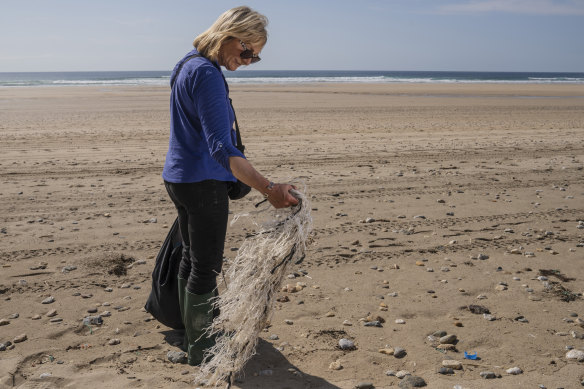
Tracey Williams was part of a beach cleaning network when she regularly found Lego pieces on the beach near her Cornwall home.Credit: The New York Times
The event and its aftermath are documented on social media on the Lego Lost at Sea Facebook page, where Hardstaff learned the history. “I’d seen some people had found these dragons,” she said. “Otherwise, I would have had no idea.”
Lego Lost at Sea, which also has accounts on X and Instagram, is run by Tracey Williams, who started documenting Lego finds after she moved to Cornwall around 2010.
“The very first time I went to the beach, I found a bit of Lego from the spill, and I thought that was quite astonishing,” she said.
Williams knew the story of the Great Lego Spill. Years ago, during visits to her parents’ home in Devon, she regularly took her children beachcombing. They looked for shells, sea glass and interesting pebbles. Then, in 1997, Lego pieces started washing up.
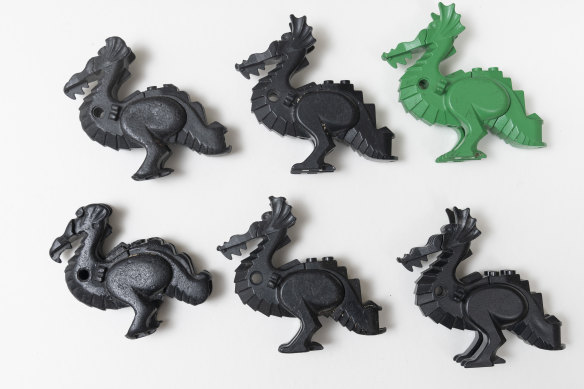
Lego dragons collected by Williams. There were 33,427 black dragons and 514 green ones on the Tokio Express.Credit: The New York Times
“We knew it’s from a cargo spill, but I didn’t know much more about it,” she said, adding that her children would fill up small plastic buckets with their beach treasures.
“I hadn’t really forgotten about the Lego story,” she said, “but it was when I came here to Cornwall and saw it washing up again and I just thought that’s astonishing, that 13 years later and this Lego was still appearing.”
Her find sparked an idea: creating a community to trace who else had found Lego, which pieces they had found and where. She created a Facebook page, and the BBC reported on it, leading to a flood of submissions.
People found tiny, colourful octopuses, dragons, life rafts, scuba flippers, scuba tanks, seagrass and more, and they enthusiastically reported their finds to the page. “At last,” read a blurb from a recent find, “after years of searching I find my very first piece of lego, lost at sea.” The endeavour became a widely followed project and led to a book titled Adrift: The curious tale of the Lego lost at Sea.
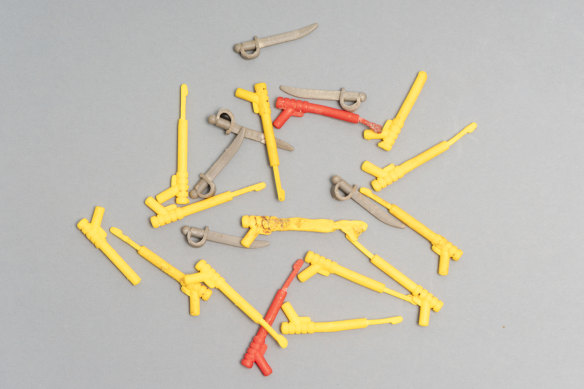
A selection of Lego swords and spear guns from Rob Arnold’s collection in Cornwall.Credit: The New York Times
Over the years, Williams has kept a record of the found pieces, including rare green dragons (only 514 were in the container) and black octopuses (4200) that have become prized finds for beachcombers. She’s mapped where the toys have turned up – on the English coast, in Wales, France, Belgium, Ireland and the Netherlands. But it’s possible pieces have drifted all over the world by now.
For Curtis Ebbesmeyer, there’s no doubt about it. Ebbesmeyer is an oceanographer known for tracking the Friendly Floatees Spill in 1992, in which thousands of rubber ducks and other bath toys washed into the Pacific Ocean. He said ocean currents were “like the world’s greatest subway line.”
“They take anything, anywhere,” he said.
After the Cornwall spill, Ebbesmeyer reached out to Lego to ask what had been on the ship. The company sent him an inventory, along with a sampling of the kinds of pieces that had been in the container. He promptly tested them in his bathtub for buoyancy and found that half of the pieces floated.
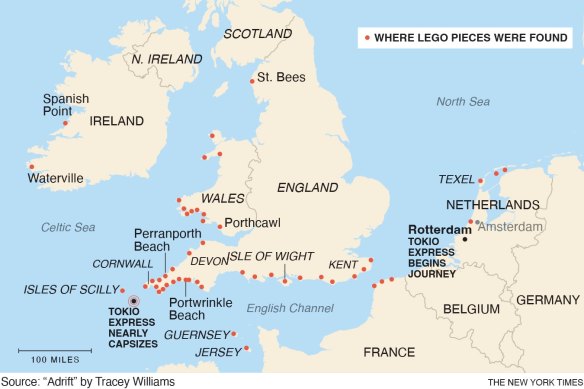
Williams has mapped where the Lego has turned up. It’s possible pieces have drifted all over the world by now.Credit: Adrift via The New York Times
That difference could account for the missing Lego pieces that fell off the Tokio Express in 1997 and have yet to surface. Williams said she regularly spoke to fishermen who discovered the pieces as they trawled the bottom of the ocean. A Lego shark, one of 51,800 that were in the container, was caught in a fisherman’s net 32 kilometres off the Cornish coast in late July. It’s the first of the sharks to see daylight in 27 years.
“Only another 51,799 to find,” Williams wrote on the Lego Lost at Sea account.
Andrew Turner, a professor of marine and environmental biogeochemistry at the University of Plymouth in England, said the Great Lego Spill was an interesting case study because of the public’s knowledge of it. Often, container spills aren’t made public unless there’s something hazardous or toxic inside. It’s also the “tip of the iceberg” when it comes to plastic pollution in the ocean, he said.
“There’s so much plastic on the bottom of the ocean that we just don’t know anything about, and how much is there, and when and if it’s going to wash up,” Turner said.
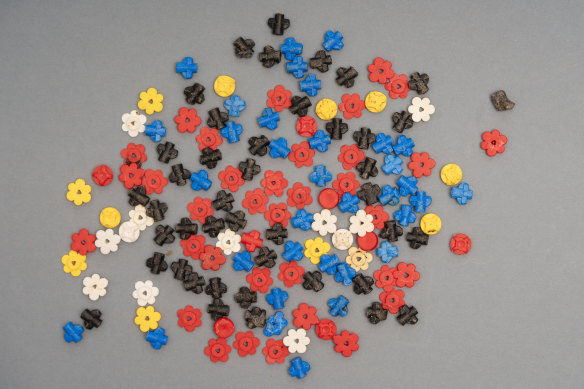
Lego flowers from Rob Arnold’s collection.Credit: The New York Times
The container mishap created an expected public relations challenge for the company that makes the toys. Calling the Great Lego Spill “an unfortunate accident,” a spokesperson for the Lego Group said the company didn’t “ever want Lego bricks to end up in the sea”.
“We are serious about our role in helping to look after the planet,” the spokesperson said. “We have an ambitious sustainability strategy that aims to leave a positive impact for future generations.”
Christopher Reddy, a senior scientist at the Woods Hole Oceanographic Institution, said that scientists were still forming an understanding of how plastic affects the ocean and marine life. The plastic pieces – which can be mistaken for food by wildlife, or even become small enough to enter the body through the gills – are harmful, but Reddy said the most worrying threat to the ocean was the increasing carbon dioxide in the atmosphere that’s fuelling climate change.
Rob Arnold, an artist in Cornwall, creates work from plastics he has recovered from the English coast. He is looking to reduce marine plastic pollution and spread awareness about it. Armed with garbage bags and sheer grit, he goes out on long, sometimes arduous walks. He climbs over rocks to reach hidden coves where trash piles up, collecting water bottles, plastic teeth, bottle caps and, yes, Lego.
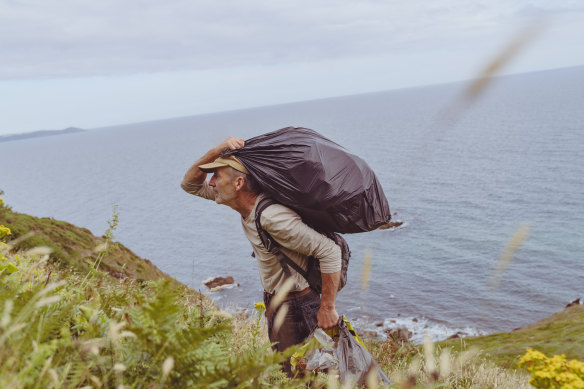
Rob Arnold, an artist who uses discarded plastic in his work, walks along a secluded stretch of Cornish coastline collecting rubbish.Credit: The New York Times
He is a reluctant artist. Arnold said he “would much prefer that material wasn’t there, and I was making art out of something nice”.
He has created an hourglass filled with plastic pellets, called nurdles; a Stonehenge built out of lighters; and a piece with nearly 1000 Lego flippers, or scuba fins, arranged neatly in rows.
For some, caring for the ocean and the surrounding environment can go hand in hand with a love of the hunt for Lego. Williams, the Lego Lost at Sea founder, has long been part of a beach clean-up network.
Hardstaff, the marine biologist, said she was always on the lookout for plastic and other trash to clean up at her local beach. But the Lego black dragon, she said, “I was happy to keep instead of throw away”. Its nearly 30-year journey ended on her bedside table.
Arnold said the Great Lego Spill captured people’s attention and raised awareness about plastic pollution.
“Hoping we’re going to find some Lego,” Arnold said, makes beach cleans “a bit more fun”.
This article originally appeared in The New York Times.
Get a note directly from our foreign correspondents on what’s making headlines around the world. Sign up for our weekly What in the World newsletter.